|
Reviews
in Undergraduate Research - Issue 1
| HIGHLIGHTS,
DISCOVERIES, RESEARCH, AND APPLICATIONS OF CONDENSED MATTER PHYSICS
}
Kristen Rogers
Emory University
Dr. M. Brian Maple: Univ. of San Diego, Dept. of Physics
Communicated by: Dr. Edmund Day - Emory University, Dept. of Physics |
SUMMARY
In this survey of condensed matter physics, fundamental knowledge of
the evolution and characteristic properties of the field will be discussed.
Current trends in condensed matter physics will be identified along
with their significance to the field. The reader will be exposed to
research that is currently a work in progress in the sub-field of solid-state
physics. The research concerns the system Ce1-xYxRhIn5
where heavy-fermion, antiferromagnetic behavior and superconductivity
are being explored through measurements of electrical resistivity between
temperatures of 1.8 K£ T
£ 300 K. Future research and technological applications
from the field of condensed matter physics are also identified and explored.
INTRODUCTION
At the commencement of the 20th century, the foundations of knowledge
of the macroscopic properties of matter were largely established. The
fields of thermodynamics, elasticity, magnetism, and hydrodynamics collectively
provided a thorough description of the "static and dynamic properties
of gases, liquids, and solids at lengths long compared to molecular
lengths" (Chaikin). In the 1920's, the discipline of "conventional
solid state physics" emerged with the study of the quantum properties
of solids (Chaiken). The areas of crystallography, elasticity, and magnetism
were incorporated in the 1940's to define "solid state physics"
in broader terms (Kohn). Accomplishments in the area of solid state
physics have included the description of the quantum Hall effect, electronic
band theory, and the detection of x-rays.
Two decades later, the 1960's, the science of condensed matter physics
was introduced in an effort to study the physical properties of liquids,
which resulted in an integration of the field of solid state physics
(Kohn). Today, the discipline of condensed matter physics is defined
as the
…fundamental
science of solids and liquids, states of matter in which the constituent
atoms are sufficiently close together that each atom interacts
simultaneously with many neighbors. It also deals with states
intermediate between solid and liquid [e.g., liquid crystals,
glasses, and gels], with dense gases and plasmas, and with special
quantum states [superfluids] that exist only at low temperatures.
All of these states constitute what are called the condensed states
of matter (Panel on Condensed Matter Physics).
The evolution of this topic
is important due to its radical advances and influences in "new
experimental discoveries and techniques of measurement, control of the
compositions and atomic configurations of materials, and new theoretical
concepts and techniques" (Kohn). An example of a paradigm introduced
by CMP is "the quantum-mechanical foundation of the classical sciences
of mechanics, hydrodynamics, thermodynamics, electronics, optics, metallurgy,
and solid-state chemistry" (Panel on Condensed Matter Physics).
The technological innovations that are attributed to CMP include and
are not limited to solid state lasers and lighting, superconducting
magnets, and highly sensitive detectors of radiant energy (Panel on
Condensed Matter Physics).
The discovery of superconductivity occurred in 1911 through the research
of Kamerlingh-Onnes (Kresin, 4). Kamerlingh-Onnes discovered that the
electrical resistance of mercury abruptly vanished at very low temperatures
close to 4 K (Kresin, 4). Materials that exhibit superconductivity have
a characteristic critical temperature TC. Above this finite
temperature, the material acts in its normal state and displays resistance,
which is "the flow of electric current that accompanies the development
of heat and the dissipation of energy" (Owens, 25). Below the TC,
the material enters a superconducting state where there is no electrical
resistivity [material conducts electricity without losses] (Owens, 25).
The characteristics of superconducting materials are not limited to
the absence of electrical resistivity. They also include "anomalous
magnetic, thermal, and other properties, so it is more precise to talk…(about
superconductivity as) a peculiar state of matter observed at low temperatures"
(Kresin, 5). In 1933, William Meissner showed that materials in their
superconducting state displayed the property of perfect diamagnetism,
the "complete expulsion of a weak magnetic field from the interior"
(Kohn, S72). It was not until 1986 that high temperature (high TC)
superconductivity was discovered (Owens, 25). Today's studies have yielded
high TC's of up to 160 K, but the mechanisms behind this
phenomenon remain to be a mystery- as does the "experimentalist's
dream" of room temperature superconductors (Kohn, S73).
In 1964, the Japanese theoretical physicist Juan Kondo was successful
in explaining the effect of a localized impurity spin on the scattering
of conduction electrons at low temperatures (Kohn, S68). This phenomenon,
now identified as the Kondo Effect, is briefly described in terms the
Kondo temperature (TK). At TK, the conduction
electrons in a metallic, non-magnetic material respond to the addition
of a magnetic impurity atom by creating a magnetic shield that offsets
the introduced magnetization. For T«TK,
the shield consists of a "singlet state with the conduction electrons"
and causes a disappearance of the magnetic susceptibility (Kohn, S68).
The exploration of condensed matter energy states in the 1980's contributed
to the interest in a new class of metals and systems called heavy-fermion
systems. These materials are depicted as possessing electronic states
that have "characteristic energy orders of magnitude smaller than
[those] in ordinary metals " (Fisk/Ott). Numerous heavy-fermion
systems are "intermetallic compounds in which one of the constituents
is a rare-earth or actinide atom, with partially filled 4f- or 5f- electron
shells" (Fisk/Ott). At high temperatures, heavy-fermion materials
tend to behave as if the f-electrons are localized in their atomic states
like conventional paramagnets in which the moments are random and tend
to want to line up with the induced magnetic field (Fisk/Ott). At low
temperatures, some of the f-electrons of the heavy-fermion system tend
to become itinerant and order spontaneously with mostly antiferromagnetic-
moments align by periodically alternating directions-, or less frequently
ferromagnetic- moments align parallel-, properties (Fisk/Ott).
On an elementary level, the building blocks of condensed matter are
formed through the logical combining of "electrons and nuclei to
atoms and molecules" in large quantities (~1024/cm3)
(Panel on Condensed Matter Physics). The crystal lattices of these systems
are considered to be either periodic or non-periodic. Periodic crystal
lattices occur for simple systems of crystalline solids on an atomic
scale (Kohn, S69). Non-periodic lattices are easily attainable in extensive
systems where defects occur within in the materials due to fluctuations
in temperature (Kohn, S68). Substitution alloys compose a class of relatively
non-periodic systems and are denoted by the generic formula AxBx-1 (Kohn,
S69-70). The elements A and B are selected such that the elements possess
identical valences [number of electrons occupying the outermost energy
levels], matching crystal structures [in their pure form], and similar
atomic radii (Kohn, S69-70). The Experimental section of this paper
will utilize the substitution alloy relationship by discussing the elements
Cerium and Yttrium in experimental context.
RECENT DISCOVERIES
Superconductivity
of Buckyballs
Experimental research in the area of condensed matter physics during
1990 led to the discovery of buckyballs (Levi, 15). A buckyball is
a spherical molecule composed of 60 carbon atoms that is easily manufactured
in large quantities through simple techniques (Levi, 15). By 1991,
"a crystal of C60 molecules had been found to superconduct
when doped with alkali metals atoms, which cede electrons to the C60
lattice" (Levi, 15). Doping results in a material that either
adds extra electrons to the material (which is then called N-type
for the extra negative charge carriers) or creates "holes"
in the material's crystal structure (which is then called P-type because
it results in more positive charge carriers). In January of 2001,
Jan Hendrik Schön, Christian Kloc, and Bertram Batlogg of Bell
Labs, Lucent Technologies, discovered a new method of "injecting
holes directly into the top layer of a C60 crystal without
adding any ions to it" (Levi, 15). In addition, the experimenters
explored the behavior of the buckyball crystal by varying a continuous
doping level from positive to negative values (i.e. adding less holes,
positive charges, to a material and increasing the number of electrons
to yield a more negative charge).
The endeavors by the Bell Labs trio led to the discovery that the
hole-doped (positive charged) C60 crystal had a maximum
critical temperature of 52 K at a doping level between 3.0 and 3.5
holes per molecule (Levi, 15). In comparison to the negative charge
injection near 3 electrons per molecule, the critical temperature
(TC) of the C60 material was only 11 K (Levi,
15). These results are important to the study of superconductivity
in buckyballs for two main reasons: 1. the peaking of the TC
for negative charge and hole doping of three electrons per molecule
or three holes per molecule emphasizes that superconductivity favors
the structure of 3 electrons per molecule, or A3C60
where A is an alkali atom; 2. "hole doped C60 crystals
turned out to be better superconductors than their electron-doped
cousins" with much larger ranges of superconductivity (Levi,
15).
Continued research on the carbon-60 materials has led experimentalists
to the realization that doping with larger atoms tends to expand the
crystal lattice (Levi, 15). The resultant expansion thus causes broader
spacing which "further reduces the overlap between the electron
bands of adjacent molecules and narrows the bandwidths" (Levi,
15). The TC affects the lattice through an inverse relationship
with the bandwidth, the larger the doping atom, the higher the TC
(Levi, 15).
In January of 2001, the primary objective of the Bell Labs trio was
to "incorporate interstitial ions that [would] expand a hole-doped
C60 lattice" and hopefully raise the TC
well above 100 K (Levi, 15). In a time period of just nine months,
the team was successful in accomplishing their goal as the TC
of the carbon-60 crystal was made to superconduct at a temperature
of 117 K. The researchers were successful is raising the TC
as a result of a new approach, electronic hole-doping with "neutral
molecules to [assist in] expand[ing] the crystal [lattice]" (Levi,
19). The neutral molecules, tribromomethane (CHBr3), caused
an expansion in the cubic lattice constant from 14.16 Å to 14.43
Å and a TC of 117 K (Levi, 21). (A cubic lattice
is generally described in terms of a unit cell with a cubic structure.
The cubic structure includes three primary lattice vectors of equal
magnitude (i.e. equal sides) and angles of 90° between each edge.
The magnitude of the lattice vectors (i.e. length of each side) is
referred to as the lattice constant.) Comparatively, when CHCl3
was used as a neutral molecule, the TC was only 80 K (Levi,
21). Experimentalists at Bell Labs are now searching for other neutral
molecules that will expand the lattice constant in order to reach
superconducting critical temperatures of 150 K (Levi, 21). If feasible,
the future of thin-film electronics will benefit immensely (Levi,
21). Overall, the discovery of superconducting buckyballs is important,
according to Robert Cava of Princeton University, because it means
that thermodynamics is the only thing that has prevented physicists
from unearthing more 100 K plus superconductors (Levi, 21).
Ferromagnetic Superconducting
Material
A superconducting state is produced through lattice vibrations in
low TC materials or through magnetic fluctuations in high
TC materials that tend to push electrons together and expel
any existing magnetic fields (Day, 16). Roughly one year ago, Gil
Lonzarich's group at the Cambridge University and their collaborators
at Grenoble's Atomic Energy Commissariat discovered that UGe2,
an alloy of uranium and germanium, "exhibited superconductivity
and ferromagnetism simultaneously" (Day, 16). Now, another ferromagnetic
superconductor, ZrZn2, has been found to exist through
the research of Christian Pfiederer of the University of Karlsruhe
(Day, 16).
The compound ZrZn2 is interesting because each component
is paramagnetic, but together the system displays weak ferromagnetism
with a Curie temperature, Tm, of 25 K (Day, 16). This point
marks the "highest temperature at which magnetic order prevails"
(Day, 16). When Pfiederer studied the samples of ZrZn2
at varying pressures, he found that the compound had a superconducting
transition at ambient pressure and at pressures lower than the critical
pressure (Day, 17). The temperatures TC and TM
were found to fall linearly in pressure from their ambient values
until each vanished at the same critical pressure of 2.1 GPa (gigapascals)
(Day, 17). The data presented above shows "strong evidence that
the same electrons mediate both superconductivity and ferromagnetism.
The high critical pressure indicates that superconductivity in ZrZn2
occurs firmly in the ferromagnetic state, rather than close to the
quantum critical point" (Day, 17). The study of ferromagnetic
superconducting systems is hoped to lead to scientists to understand
the phenomenon behind the high TC superconductors (Day,
16). Also, the information gathered from the UGe2 and ZrZn2
systems strongly suggests that superconductivity is no longer an isolated
phenomenon, but a generic effect caused by magnetic fluctuations (Day,
18).
EXPERIMENTAL
What and Why?
Recently, it was discovered that heavy-fermion systems exist in Ce-based
compounds with the structure CeRhIn5 (Thompson). Specifically,
the compound CeRhIn5 is a heavy fermion system which displays
antiferromagnetism but does not superconduct at ambient pressure.
The Maple Lab at the University of California at SanDiego is currently
exploring the compound CeRhIn5. The nonmagnetic element
Yttrium, Y, was added to the compound, CeRhIn5 to yield
the compound Ce1-xYxRhIn5, thus diluting
the Ce magnetic moments. The element Yttrium was chosen because of
its nonmagnetic properties and ability to be a substitution alloy
in conjunction with the element Ce. Yttrium and Cerium are substitution
alloys for three reasons: 1. each possesses three valence electrons
(Cerium possesses 3 valence electrons at ambient room temperature
and pressure. However, when subject to cooling or compression, the
valency changes from about 3 to 4.); 2. the atomic radii are similar
with Ce=2.7Å and Y=2.27Å; 3. in their pure form both Ce
and Y have a close packed hexagonal structure. The objective of studying
the system Ce1-xYxRhIn5 with 0£
x £ 1 was to explore the magnetic
phase diagram, and to search for possible non-Fermi liquid behavior
at a quantum critical point where the Néel temperature, TN,
is suppressed to near 0 K or very low temperature ranges. The Néel
temperature is the critical temperature of an antiferromagnetic material
above which paramagnetism occurs.
Experimental Details
Single crystals of the intermetallic compound form Ce1-xYxRhIn5
were prepared and grown using a molten In flux technique in alumina
crucibles, which were sealed under vacuum in quartz tubes. The molten
Indium flux technique requires that the Indium surround the starting
materials (with the higher melting temperatures on the bottom) inside
the crucible. As the low-melting materials melt they flow over the
higher-melting materials and incorporate them into the melt. The crucibles
were heated inside a furnace to a temperature of ~1100°C for 24
hours and then cooled slowly (at ~5°C/hour) to 600°C. The
samples were then removed from the furnace, immediately inverted,
and centrifuged at room temperature, in an effort to remove the molten
Indium.
In order to ensure the correct structure of each sample, powder diffraction
x-ray data was taken. The peaks from the experimental data were then
plotted and compared against those of the known theoretical CeYRhIn5
and Germanium peaks. Once all of the major peaks from the sample were
accounted for, it was concluded that the correct crystal lattice structure
had formed. If significant peaks existed in the experimental data
that were not categorized as concentrations of In, Ge, or CeRhIn5,
the sample was assumed to contain impurities. The lattice constants
for each compound were determined by comparing the angles of the experimental
peaks to the indices and angles of the simultaneous theoretical peaks.
Then XLAT, a Least Squares (LSQ) program, used the resultant theoretical
indices and experimental angles to calculate the precise refinement
of lattice constants (a, b, c) in units of Angstroms. The lattice
constants for the Ce1-xYxRhIn5 data
were calculated for a tetragonal lattice system where a = b
¹ c.
Resistivity was measured as a function of temperature in a 4He
cryostat. (Usually neutron diffraction measurements are necessary
to determine the magnetic structure of the compound. Resistivity provides
us with a hint, as we can postulate that there might be a Néel
temperature if we see a kink.) The resistivity slices were prepared
by attaching gold leads to the sample with silver epoxy. Temperatures
in the range of 1.8K to 300 K were generated for each resistivity
slice (preferably long, thin rectangular crystals of the sample) within
the Ce1-xYxRhIn5 system being studied.
Once the resistivity slices were placed into the 4He cryostat, a magnetic
field of 300 Oe was applied to overcome Indium's superconducting state
and a maximum current flow of 10mA with a 16 Hz frequency was produced
in order for the resistivity slice to reach low temperatures without
interference.
RESULTS
Crystal Formation
X-ray diffraction measurements
reveal whether or not a specific compound of the type Ce1-xYxRhIn5,
0 = x = 1, has formed the correct tetragonal crystal structure. The
graphical representations of the x-ray diffraction measurements for
Ce.1Y.9RhIn5 are located in figure
1 and 2, with 2 representing a zoomed view. The plot consists of experimental
Ce.1Y.9RhIn5 and theoretical Ge,
CeRhIn5 data for intensity (counts) vs. angle (q).
The peaks in the plots result from variations in intensity where "for
only certain values of q will the reflections
from all parallel planes add up in phase to give a strong reflected
beam"- specular reflection (Kittel). A calibration standard,
Germanium, was used to reveal phase shifts in the experimental peaks
relative to CeRhIn5 by mixing powdered Germanium with the
powdered sample, x-raying the two substances, and comparing the known
location of the theoretical Ge peaks with those from the experimental
sample. Upon a close analysis of Figure 1 it is apparent that all
of the major experimental peaks are accounted for by the theoretical
data. Hence it can be easily determined that the sample compound Ce.1Y.9RhIn5
formed the correct tetragonal crystal lattice structure. Similar processes
and graphical representations were used to ensure that each compound
of the Ce1-xYxRhIn5 system formed
the tetragonal crystal structure.
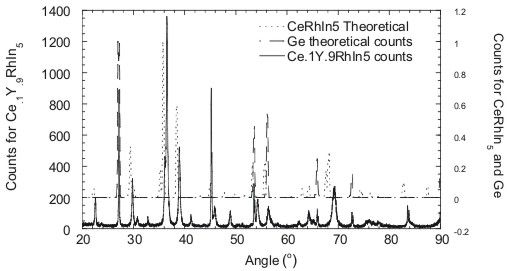 |
| Figure 1. Graphical
representation of the x-ray diffraction measurements for Ce.1Y.9RhIn5
against CeRhIn5 theoretical and Germanium theoretical.
The graph is plotted as intensity vs. theta for 20°
£ q £ 90°. |
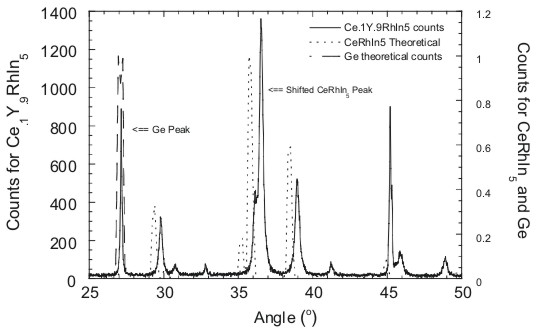 |
| Figure 2. Magnified
version of the graphical representation of the x-ray diffraction
measurements for Ce.1Y.9RhIn5
against CeRhIn5 theoretical and Germanium theoretical.
The graph is plotted as intensity vs. theta for 20°£
q £ 50°. |
Crystal Parameters
The x-ray diffraction measurements reveal that the crystals formed
in the tetragonal CeRhIn5 structure. The lattice constants
for the Ce1-xYxRhIn5 system are a
and c. These are plotted as a function of x, Yttrium concentration,
in figures 3 and 4. A linear relationship should exist between the
concentration of the substitute element and the size of the lattice
parameters, which is called Vegard's Law. The direction of the linear
relationship, increasing or decreasing, depends upon the system being
analyzed. The graph for lattice constant a follows the rules set forth
in Vegard's law. Figure 3 shows that as the concentration of Yttrium
is increased, lattice constant a decreases, implying the cell is contracting
along the a axis.
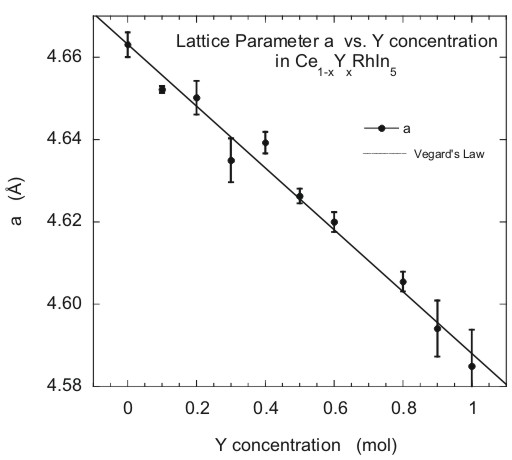 |
| Figure
3. Tetragonal lattice constant a as a function of Y concentration
x for the Ce1-xYxRhIn5 system.
The dotted line is a fit to the data and the solid line represents
the linear relationship of Vegard's law. |
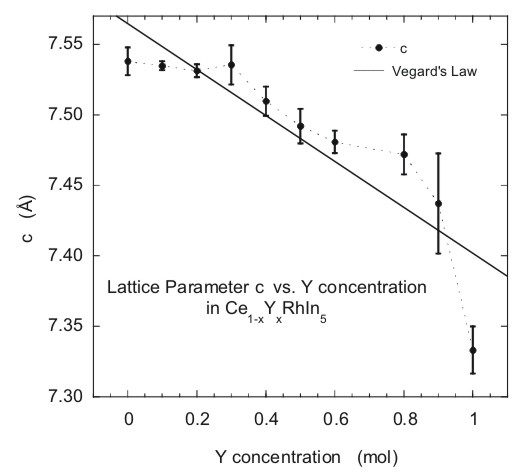 |
| Figure
4. Tetragonal lattice constant c as a function of Y concentration
x for the Ce1-xYxRhIn5 system.
The dotted line is a fit to the data and the solid line represents
the linear relationship of Vegard's law. |
The graph for the c lattice
parameter is shown in Figure 4. The relationship between the size
of the c parameter and the concentration of Yttrium does not obey
Vegard's law. Instead, the curve appears constant for 0 £
x £ 0.3, and then a decreasing linear
dependence occurs on x for x ³ 0.3.
Overall, the results from Figures 3 and 4 provide evidence for a contracting
cell structure along the a, b, c axes (where b = a) as the larger
Yttrium ion is substituted on the Cerium site.
Electrical Resistivity
The normalized electrical "resistivity," r/r(300K)
vs. T of various Ce1-xYxRhIn5 compounds
is displayed in Figures 5 and 6. Figure 5 compares the resistivity
for concentrations of .2 £ x £
.8 while Figure 6 displays that of x=1 and x=. 9. The resistivity
for .2 £ x £
.8 are weakly temperature dependent for temperatures above ~100 K.
Below ~100 K a considerable decrease in slope tends to occur with
a hump around ~50 K. For T<50 K there is a rapid decrease in r(T)
with decreasing T. This decline is caused by the onset of coherence
in the Cerium ion sublattice. The end member compound CeRhIn5
exhibits similar behavior to the concentrations of .2 £
x £ .8. Upon close examination of
the slopes in Figure 5, there is no consistency, as the slopes do
not decrease nor increase with increases in the concentration of Yttrium.
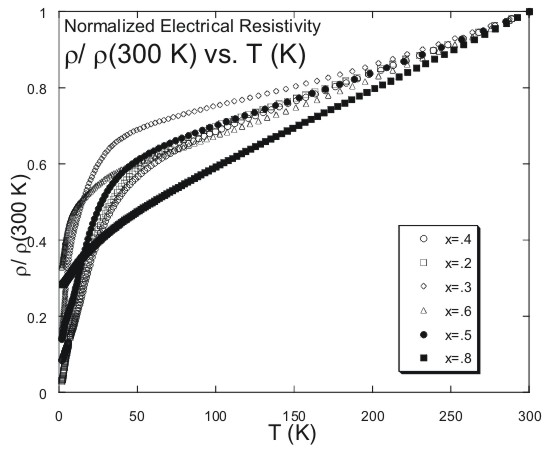 |
| Figure 5. Electrical
resistivity r normalized to its value at 300 K, r/r(300
K), as a function of temperature for Ce.1Y.9RhIn5
with .2 £x £.8
and x = .8. |
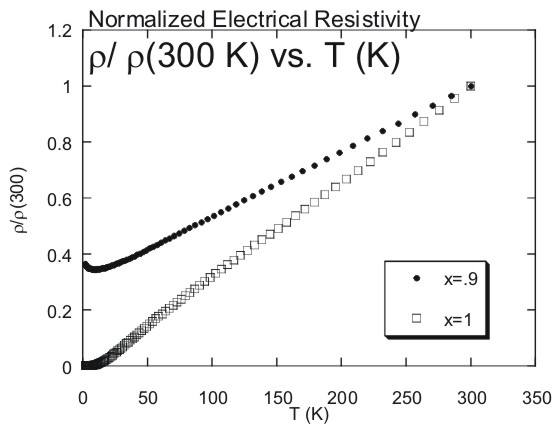 |
Figure
6. Electrical
resistivity r normalized to its value at 300 K, r/r(300
K), as a
function of temperature for Ce.1Y.9RhIn5
with x = .9 and x = 1.0. |
The concentrations of x
displayed in Figure 6 exhibit behavior that is different from those
of the other x concentrations. The resistivity of the curves for x=0.9
and x=1 are weakly temperature dependent for temperatures above ~100
K. Below ~100 K a rapid decrease occurs in r(T)
with decreasing T. A minimum occurs at ~20 K for x = 0.9 and then
a slight increase in resistivity occurs for T< 25K. For x=1, YrhIn5,
r(T) decreases rapidly until ~50 K and
then begins to level off slightly for T < 50 K. The graphs of resistivity
for 0£ x £
1 do not display the Néel temperature where the onset of antiferromagnetism
may occur as in some systems a kink is seen in the resistivity at
the Néel temperature. It is suspected that antiferromagnetic
ordering will occur for T< 1.8 K. The graphs do reveal the presence
of the Kondo effect. Figure 5 displays an increase in resistivity,
upturn in the curve, for T< 1.8 K while Figure 6 reveals a definite
increase for x = 0. 9. There are no magnetic ions in YRhIn5,
x = 1.0, which result in a lack of the Kondo effect. There is no presence
or implication of superconductivity revealed in the resistivity data
for 1.8 K £ T £
300 K. The samples with x = 0.4, 0.5, 0.6 have linear r
vs. T relationship, whereas Fermi-liquid theory predicts a T2
temperature dependence of the resistivity. The possibility of non-Fermi
liquid behavior in these samples needs to be explored further with
specific heat and magnetization measurements.
CONCLUSION
The structure of the Ce1-xYxRhIn5 system
was characterized by tetragonal powder diffraction x-ray measurements.
The lattice parameters of this system were shown to decrease with increasing
concentrations of Yttrium under ambient pressure and temperature. This
provides evidence for a contracting cell structure. Measurements of
electrical resistivity for 1.8 K £
T £ 50 K provide evidence of the Kondo
effect. The experimental results offer no evidence of superconductivity.
Further investigation of the Ce1-xYxRhIn5
system should include tracking the suppression of the Néel temperature
with increasing Yttrium by means of specific heat and neutron scattering
measurements. Also, the physical properties of resistivity, specific
heat, magnetic susceptibility, and nuclear magnetic resonance should
be investigated at low temperatures in the vicinity of the quantum critical
point, TN, to determine if non-Fermi liquid behavior is observed.
A detailed investigation of these systems should enhance our understanding
of the interplay of magnetism, superconductivity, and non-Fermi Liquid
behavior in correlated electron system.
FUTURE POSSIBILITIES
FOR RESEARCH AND APPLICATION
Polymeric Carbon-60
Recently, a collection of
experiments has revealed ferromagnetic behavior in polymerized C60
at temperatures near 500 K (Levi). Scientists are skeptical of this
discovery because the "constituent molecules have no magnetic
moments" (Levi, 18). Further investigation into this system is
necessary in order to explain how and why a system composed solely
of carbon can be magnetic if there are no unpaired electrons (Day,
18). Other research interests in carbon lie in the possible industrial
aspects of the material. Companies are interested in finding a molecular-based
material that can be cheaply manufactured and easily modulated (Levi,
18). However the samples and testing are costly (Levi, 18).
Solid State Lighting
A dilemma that is becoming more widespread every year is the challenge
of generating electricity. The process is becoming more costly economically
and environmentally as the years progress. The current state of lighting
focuses mainly on incandescent and florescent sources (Bergh, 42).
However, lighting applications that use Light Emitting Diodes (LEDs)
and Organic Light Emitting Diodes (OLEDs), commonly referred to as
Solid-State Lighting (SSL), are being developed. In SSL, a semiconductor
converts electricity to light. The life of the device depends on packaging
considerations, drive current, and the operating environment (increased
temperatures produce lower light output). SSL offers economic and
environmental savings over the current incandescent sources through
long life, high efficiency, low voltage, and vibration and shock resistant.
It is proposed that with SSL the US would be able to reduce lighting
expenditures between 2000-2050 by $100 billion and spare 28 million
metric tons of carbon emission into the atmosphere annually (Bergh,
42).
Other benefits of SSL include variety, aesthetics, and durability.
The circuitry of SSL allows for control over the size, color, intensity,
and design, thus resulting in light coloring similar to that of the
sun and allowing physical features such as "flat packages of
any shape that can be placed on floors, walls, ceilings, or even furniture"
(Bergh, 42). Overall, SSL offers consumer friendly advantages that
will revolutionize light sources over the next few decades.
ABOUT THE AUTHOR
Kristen Rogers is a junior at Emory University where she is pursuing
a bachelor of arts and science in both physics and mathematics. Upon
graduation in May 2003, Kristen intends to pursue a PhD in one of the
areas of experimental physics. Her final career goal is to develop national
security technology for the United States Navy.
The research that Kristen conducted during the summer of 2001was completed
through the REU program offered at the University of California at San
Diego. There, she worked in the Maple Condensed Matter lab under the
supervision of professor M. Brian Maple and graduate student Vivien
Zapf.
Kristen concentrated her interests in low-temperature solid-state physics.
The focus of her research was on the heavy fermion system Ce1-xYxRhIn5.
This compound was of particular interest due to its display of antiferromagnetic
behavior and lack of superconductivity at ambient pressure. Kristen
participated firsthand in preparing the samples of the compound Ce1-xYxRhIn5
with varying concentrations of Ce and Y. She also acquired experience
in measuring the magnetic properties of these compounds at temperatures
as low as 1.8K and in magnetic fields of approximately 300 Oe. The ultimate
goal in studying Ce1-xYxRhIn5 was to
determine if the same antiferromagnetic, heavy fermion activity would
be exhibited as that in the compound CeRhIn5 when slowly
adding Y and subtly eliminating Ce to the compound. The results, thus
far, imply that antiferromagnetic behavior does exist and competition
occurs at low temperatures between the Kondo effect and antiferromagnetism.
This project is currently undergoing extensive research at UCSD. However,
Kristen will no longer be an active participant due to academic obligations
in Atlanta.
ACKNOWLEDGEMENTS
I would like to thank Professor M. Brian Maple, UCSD Physics Department,
and the National Science Foundation 2001 Research Experience for Undergraduates
program for enabling me the opportunity to partake in innovative, exciting
physics research. I would also like to thank each member of the Maple
lab for his/her kind support. In particular, I am especially grateful
to Vivien Zapf for all the time and patience she devoted to my education,
equipment know-how, and pestering questions.
FURTHER READING
1. Fisk, Z., Hess, D.W., Pethick, C.J., Pines, ., Smith, J.L., Tompson,
J.D., Willis, J.O. (1988). Heavy-Electron Metals: New Highly Correlated
States of Matter. Science, Vol 239.
2. Curro, N.J., Hammel, P.C., Pagliuso, P.G., Sarrao, J.L., Thompson,
J.D., Fisk, Z. (2000). Evidence for spiral magnetic order in the heavy
fermion material CeRhIn5. Physical Review B, Vol. 62, No.
10.
3. Kittel, Charles. (1995). Introduction to Solid State Physics. (ed.
7 New York, New York: John Wiley and Sons Inc).
4. Kresin, Vladimir Z., Wolf, Stuart A. (1990). Fundamentals of Superconductivity.
(New York, New York: Plenum Press).
REFERENCES
Bao, Wei. Pagliuso, P.G.,
Sarrao, J.L., Thompson, J.D., Fisk, Z. (2001). Magnetic Structure of
heavy fermion Ce2RhIn8. yet to be published, references to be cited
therein.
Bergh, Arpad, Craford, George,
Duggal, Anil, Haitz, Roland. (2001). The Promise and
Challenge of Solid State Lighting. Physics Today. Vol 54, No. 12, 42-47.
Chaiken, P.M., Lubensky,
T.C. (1995). Principles of Condensed Matter Physics. (New
York, New York: Press Syndicate of the University of Cambridge) xvii.
Day, Charles. (2001). Second
Material Found that Superconducts in a Ferromagnetic
State. Physics Today. Vol. 54, No. 9, 16-18.
Fisk, Z., Ott, H.R., Rice,
T.M., Smith, J.L. (1986). Heavy-Electron Metals. Nature. Vol.
320, No. 37, 1.
Kittel, Charles. (1967).
Introduction to Solid State Physics, ed. (New York, New York: John Wiley
and Sons Inc) 37, 38, 42.
Kohn, W. (1999). An Essay
on Condensed Matter Physics in the Twentieth Century.
Reviews Of Modern Physics. Vol. 71, No. 2, S59, S68-70, S72.
Kresin, Vladimir Z., Wolf,
Stuart A. (1990). Fundamentals of Superconductivity. (New
York, New York: Plenum Press) 4, 5.
Levi, Barbara Goss. (2001)
BuckyBalls Found to Conduct at 52 K. Physics Today.
Vol. 54, No. 1, 15-16.
(2001) Buckyball Crystals
Made to Superconduct at 117 K.
Physics Today. Vol. 54, No. 10, 15-16.
(2001) Can Polymeric Carbon-60 Be Magnetic? Physics Today.
Vol. 54, No. 12, 18-19.
Owens, Frank J., Poole, Charles
P. Jr. (1997). The New Superconductors. (New York,
New York: Plenum Press) 25.
Panel on Condensed Matter
Physics, Physics Survey Committee, Board on Physics and
Astronomy, Commission on Physical Sciences, Mathematics, and Resources,
National Research Council (US). (1986). Condensed-Matter Physics. (Washington,
D.C.: National Academy Press) 3.
Thompson, J.D., Movshovich,
R., Fisk, Z., B ouquet, F., Curro, N.J., Fisher, R.A.,
Hammel, P.C., Hegger, H., Hundley, M.F., Jaime, M., Pagliuso, P.G.,
Petrovic, C., Phiilips, N.E., Sarra, J.L. (2000). to appear in J. Magn.
Magn. Mat. (2000), references cited therein.
|






